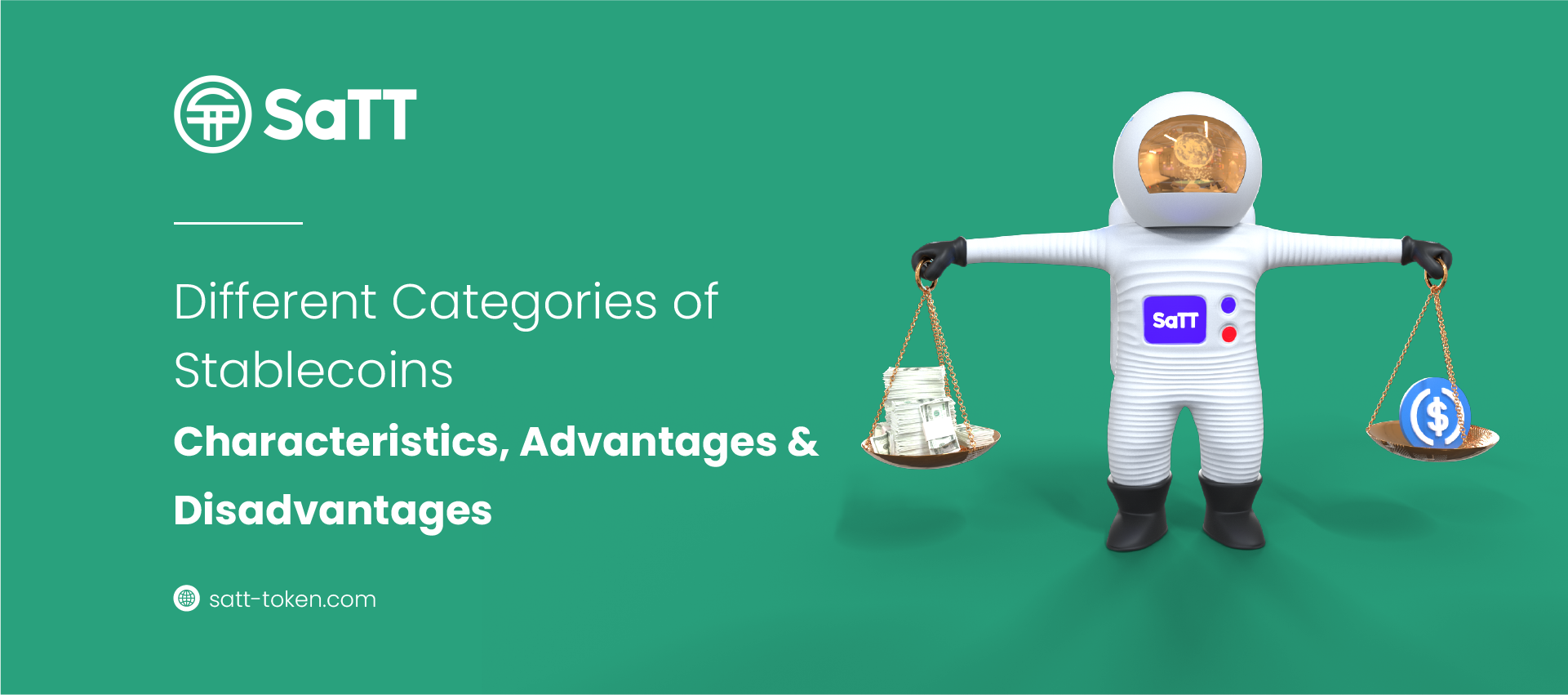
Different Categories of Stablecoins: Characteristics, Advantages & Disadvantages
The fast-growing cryptocurrency asset market has dominated the investment news channels for some time now, and the trend is not showing any signs of slowing down. More investment experts are increasingly advising investor to consider adding cryptocurrency to their portfolio. Moreover, many mainstream financial providers are adding the digital currency among services they offer. For instance, Morgan Stanley was the first big US bank to offer its wealthy clients access to crypto investment. More businesses are increasingly accepting cryptocurrency in exchange for goods and services. However, one the main challenges that is seemingly slowing down the adoption of cryptocurrency is its high volatility. You only need to look at the price movements of Bitcoin (BTC) over the last one year along to understand what volatility can do to investors in the crypto space. For example, in April this year, Bitcoin became the talk of the investment space as it rose past $64 for the first time in history. Then, in a flash, the world’s biggest crypto would drop by more than 50%, consequently wiping off $1 trillion in the crypto market in a single week. Incidentally, the Bitcoin drop leads to drop of other major cryptocurrencies such as Ethereum (ETH), albeit at varied percentages.
More recently, however, stablecoins have emerged to solve the problem of crypto volatility. Stablecoins are cryptocurrencies whose market value is pegged on an external reference, such as the US dollar, other stable commodities, or cryptocurrencies. Pegged on these more stable asset classes, stablecoins have low volatility as they imitate the price of these stable assets.
Stablecoins have become hot in demand today mainly due to the involvement of regulatory authorities certifying their existence and use. For example, USDC has been experiencing tremendous growth, which is attributed to trust after it was licensed by US-based firms. For this reason, stablecoins have become hot, and continue to grow.
The market cap has risen from $5 billion to $120 billion between 2020 and 2021. The coins are increasingly finding different use cases in the crypto space. Acting as a safe “packing space”, stablecoins serve as a bridge between fiat currencies and crypto assets.
What are the uses of stablecoins?
Stablecoins have opened numerous opportunities for holders. The common misconception has been that stablecoin prices never vary relative to the underlying currency (mostly USD). But this is not true, because stablecoins are pegged to a fixed unit, although in reality, their market prices fluctuate around that level. The price movements allow for the arbitrage opportunity, allowing investors to mint a stablecoin for $1 and sell on the market for a profit, say of $0.0002 if the sale price is $1.0002. If this small margin profit is multiplied by a million, it can generate some significant profit for the investor. As a result, stablecoins are increasingly being preferred as commodities to trade. As of September 2021, it was reported that 75% of all trading on crypto trading platforms involved a stablecoin. The coins are also increasingly being used as collateral in crypto asset derivative transactions or in decentralized finance (DeFi). Stablecoins are also used to pay salaries in crypto due the lower cost and faster transaction when moving money across borders.
In light of the stablecoin’s direct links to the traditional financial system, as well as their association with the ever-growing crypto space, we are going to highlight different categories of stablecoins, including their characteristics, advantages and disadvantages.
- Fiat currency-backed stablecoins
These are stablecoins backed by fiat currencies such as US dollar reserve uses the latter as collateral. Fiat currencies are government-issued money whose value and circulation is controlled by the government or central authority backed by the government. Fiat- backed stablecoins work in such a way that for every token in circulation, fiat-backed stablecoins have one dollar reserve behind it. Fiat currencies are audited regularly to maintain compliance. Similarly, stablecoin reserves are also maintained by the central entities by auditing their funds, working with regulators to ensure that the entities involved remain complaint.
The fiat-backed stablecoins are trusted on the backing asset’s stability, hence they are commonly used as commodities and traded on exchanges. You can also redeem them from the issuer. The maintenance cost of stablecoin is equivalent to the cost of maintain the backing reserve currency, which include legal compliance, licensing cost, auditing and business infrastructure cost imposed by the regulator.
Fiat-backed stablecoins were the first type to hit the market, which probably explains why they are the most common.
Characteristics of stablecoins backed by fiat currencies
- Value pegged on either one or more fiat currencies in a fixed ration. The most popular fiat currencies used as reserves are the US dollar, the Euro, and the Swiss Franc.
- Tethering is implemented off-chain through regulated financial institutions such as banks. These institutions serve as depositaries of the currency used to back the stablecoin. Incidentally, the marginal movement of these reserve currencies also affect the price of the backed stablecoin, hence the opportunities for traders to profit.
- The amount of fiat currency involved in the backing of the stablecoin must reflect the circulating supply of the stablecoin.
The most known fiat-backed stablecoins are USD Coin (USDC), TrueUSD (TUSD), and USD Tether (USDT) among others.
To invest in fiat-backed stablecoins directly from the issuers, users have to go through Know-Your-Customer (“KYC”) and Anti-Money Laundering (“AML”) verification stages similar those applied in the traditional financial sector like forex market. KYC and AML allow platforms issuing stablecoins to acquire your personal information, including a copy of your government-issued identification document such as driving license or passport.
Although fiat-backed stablecoins have helped merge the traditional financial industry with cryptocurrencies, the involvement of central authorities have raised controversies. For example, the central authorities issuing them may misuse the ability to freeze funds of specific addresses. Similarly, law enforcement agents have used stablecoin issuers to assist them conduct investigations and crack down on some addresses, consequently leading to the control that, ironically, is one of the issues cryptocurrency promised to challenge.
- Commodity-backed stablecoins
These are stablecoins backed by hard assets such as gold (and other precious metals), oil or real estate. They can be defined as the blockchain-based representations of these commodities. The commodities are kept by a central entity. Although gold dominate the list of commodities used, some stablecoin protocols use diversified baskets of precious metals to stabilize their stablecoin assets. The commodities can also fluctuate in price, but their relative stability give the backed stablecoin equivalent stability better than the standard cryptocurrency.
Characteristics of stablecoins backed by commodities
- The stablecoin value is fixed to one or more commodities, and you can redeem them on the same value based on demand
- They hold the promise to pay, either by regulated or unregulated financial institution.
- The amount of commodity put on reserve to back the stablecoin must reflect the circulating supply of the stablecoin.
The most popular commodity-backed stablecoin is Digix Gold Tokens (DGX).
Commodity-backed stablecoins make it easier to invest in assets that are hard to access under normal traditional investment environment. For example, acquiring a gold bar or securely storing it can be extremely hard for ordinary investors due to the costs involved. Therefore, stablecoins backed by commodities such as gold or real estate make it easier to access and anyone can easily swap tokens for cash or buy a tokenized asset.
However, the fall of price of the underlying asset may significantly affect the price of a commodity-backed stablecoin, leading to massive losses on investors. Moreover, the involvement of the unregulated central entities may compromise their legitimacy.
- Crypto-backed stablecoins
These are stablecoins backed by other established cryptocurrencies. These stablecoins can be issued to track the price of the cryptocurrencies backing them. They can also be used to track the price of a fiat currency.
To counter the relatively high volatility of backing stablecoins through crypto, the coin will maintain an overcollateralized position. That is, the stablecoin will ensure the circulation of a much lower supply against the reserve as compared to the fiat-backed currencies. For instance, the stablecoin may decide to issue $1,000 worth of coins for every $400 of crypto in reserves rather than adopting the common one-to-one ratio.
Crypto-backed stablecoins are the most decentralize stablecoins as they can be created through the use of automated smart contracts with no central entity controlling their supply and functionality. These stablecoin may have various uses, including being issued to launch one asset on a different blockchain, just like Wrapped Bitcoin (WBTC) is used to back Bitcoin issued on Ethereum blockchain. They are also used in DeFi projects. For example, if a user takes a loan from a DeFi platform and their collateral drops too close to the value of their withdrawal, they can be liquidated to compensate the lender and cover up loan cost from the platform.
Characteristics of crypto-backed stablecoins:
- Stablecoin value is collateralized by another crypto asset or a portfolio of cryptocurrencies.
- The pegging is executed on-chain with the help of smart contracts, which self-executes when the conditions are met.
- Stablecoins supply is regulated on-chain with help of smart contracts.
- In addition to collateral, other supplementary instruments and incentives are also implemented to maintain price stability.
Some of the most popular stablecoins in this category include Wrapped Bitcoin (WBTC), Havven (the pair: nUSD – stablecoin and HAV – the collateral-backed nUSD) and DAI (pair: CDP – Collateralized Debt Position and MKR – governance token used to control the supply) among others.
The implementation of crypto-backed stablecoins is, however, usually more complex than other categories such as fiat-backed ones. For example, the smart contracts may be prone to bugs and code manipulation, which may increase the risks of losses given they are never regulated by any third-party centralized entities. The problems may limit their usage as it become difficult to know how the price moves. Overcollateralization may also be a problem as it is likely to lock out those unable to give such amount of collateral.
- Algorithm-backed stablecoin
Also known as hybrid stablecoins, these stablecoins are backed by processes rather than another asset or currency. They use smart contracts to serve as the intermediary between the backing asset and the stablecoin.
The algorithmic stablecoins function as real central banks, defending the peg of their currency in the market. When the price of the stablecoin goes over the peg they buy assets and sell them when the price drops below the peg.
Some algorithmic stablecoins are known for losing their peg during black swan or unexpected events because the market volatility shoots upwards due to a lack of over-collaterization. An algorithmic stablecoin system will lower the number of tokens in circulation when the market price falls below the fiat currency’s price. Alternatively, if the token’s price exceeds that of the fiat currency it represents, new tokens are issued to bring the stablecoin’s value down.
- Non-collateralized or seigniorage-style stablecoins
Non-collateralized or seigniorage-style stablecoins are similar to algorithmically-backed stablecoins, but they do not have any reserves in smart contracts. Instead, seigniorage-style stablecoins rely on complex processes meant to adjust the circulating supply of their coins in response to supply and demand.
Non-collateralized or seigniorage-style stablecoins destroy and inflate supply on-chain to maintain their peg. No collateral is used to mint these stablecoins as they are self-collateralized. For instance, let’s assume the value of stablecoin A is $1.00. The price lowering to $0.70 shows that there is more supply than demand for a stablecoin. The algorithm buys stablecoin A with seigniorage, reducing supply and bringing the price back to $1.00.
If the price remains below $1.00 and there are not enough earnings to buy more of the coin’s supply, seigniorage shares are issued. It means users are effectively investing in the expansion of the supply of non-collateralized stablecoins. On the flip side, if the price of a stablecoin rises above $1.00, the algorithm generates more tokens, increasing supply until the price falls below $1.00. The profits are referred to as “seigniorage.”
Conclusion
A stablecoin whose value is pegged on a specific fiat currency, such as USD, or commodities such as gold, or other cryptocurrencies reliably holds the value of the backing asset over time. This makes it easy to transfer the value to the recipient if you send or spend it. For example, when you hold Bitcoin, you can easily convert it without losing much value. You can then change it into USD for ease of withdrawal into your bank account or use it to purchase goods and services.
Cryptocurrency is a free market, which has enabled developers to compete in creating stablecoins for varied functions to fulfill the needs of the target users. You can read our top 10 stablecoins to learn more.





